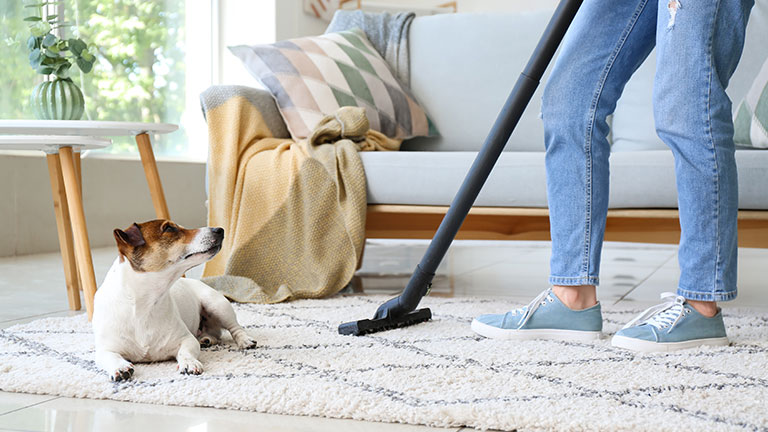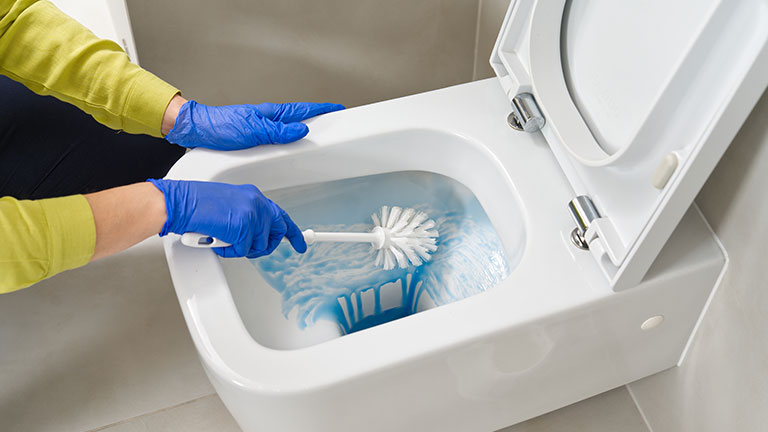How to Get Rid of Bad Smells in Your Home
From tackling mystery odors to battling pet funk, these expert tips help you eliminate odors at the source and keep your home fresh and inviting


You walk through the door, ready to relax at home, and then—it hits you. What is that smell? Suddenly, you're playing detective, wondering if it's last night's salmon dinner or if something crawled into your walls to die.
The good news? The solution is easier than you think.
Whether it's lingering cooking smells, your dog's favorite chair cushion, or a mysterious mustiness wafting from the closet, bad smells and household odors can happen in every home. With a few simple tweaks and everyday products, you can say goodbye to odors and hello to that fresh, welcoming feeling at home.
Finding the source of the smell
Before reaching for scented sprays, put on your detective hat to uncover the source of the bad smell. Experts agree: The solution isn't to cover up the stink; it’s to eliminate it.
Start with a quick “sniff test walk-through” of your home. Check the obvious culprits, such as trash cans and pet areas, as well as sneakier sources, such as sink and dishwasher drains, washing machine gaskets, and HVAC vents and filters.
Once you’ve tackled the root cause, you can move on to the right kind of refresh to clear out any lingering odors.

Eliminating kitchen smells
Think of your kitchen as ground zero for bad smells and stubborn odors, from cooking odors to trash can funk. Fortunately, it's also one of the easiest places to freshen up.
Lingering cooking smells: Pour white vinegar into a shallow pan, and let it simmer on the stove for a few hours to neutralize lingering odors. For faster results, heat a bowl of water with lemon slices in the microwave for two minutes, and then let it sit on the counter to release a citrusy scent.
Fridge funk: When the inside of your fridge starts to smell, wipe it down with hot water and baking soda (just one of many practical uses for baking soda). If odors linger, place an open box of baking soda inside to absorb them (just remember to replace it monthly).
Garbage disposal and trash: Sprinkle baking soda or cat litter in the bottom of your trash can before adding a new trash bag to absorb odors. (Swap it out once a month.) For disposals, grind up a handful of ice cubes with citrus peels to clean and deodorize.
Prevention tip: Take out the trash nightly and do quick fridge cleanouts each week—five minutes now can save you from a major stink later.

Dealing with pet odors
Pet odors can be some of the toughest to get rid of, but the right products and habits make a big difference. Look for solutions specially formulated to neutralize pet-related smells.
Litter box management: Scoop daily and give the entire box a thorough cleaning once a week. For extra odor control, add a light sprinkle of baking soda to fresh litter.
Fabric refresh: Sprinkle baking soda on pet beds, carpeted areas, and couch cushions. Let it sit for about 20 minutes, and then vacuum it up. Odor-neutralizing sprays—such as Febreze—contain ingredients that help trap and eliminate smelly compounds.
Toy and collar care: Wash pet toys and collars regularly to remove built-up grime and lingering odors. Use mild soap or pet-safe detergent, and let them dry thoroughly before reuse.
Prevention tip: Regular grooming (weekly brushing, monthly baths) can dramatically cut down on pet odors before they become problems. If your pet has an accident, use an enzyme cleaner; it breaks down organic messes more effectively than regular cleaners.

Tackling musty rooms and closets
That damp basement-like bad smell usually signals a moisture problem.
Fighting moisture: A dehumidifier is your best defense against musty odors, but moisture absorbers—such as DampRid—can also help by pulling excess water from the air. Activated charcoal works well for trapping odors in small spaces, such as closets or drawers.
Storage and fabric refresh: Place an open box of baking soda, a dryer sheet, or cedar blocks in closets to keep things smelling fresh. Wash curtains, throw blankets, and other soft items monthly.
Prevention tip: Keep air circulating with fans and open windows occasionally. Also consider keeping the bathroom door open post-shower to speed up drying. Stagnant air creates the perfect environment for mustiness to take hold.

Battling bathroom funk
Bathrooms face constant moisture, making them prime spots for mystery odors.
Drain maintenance: In infrequently used drains, water can evaporate and allow sewer gases to seep in. Run the faucet weekly to keep P-trap—the curved section of pipe under the drain that holds water— moist and functioning properly. Pour baking soda followed by vinegar down the drains once a month to help freshen them and prevent buildup.
Mildew prevention: Run the bathroom fan for 20 minutes before and after showers to prevent mildew and mold. Wash towels every few days; damp fabric is a magnet for mildew.
Hidden fresheners: Tuck cotton balls dipped in essential oils behind the toilet or under the sink for a subtle, consistent scent that lasts for a few days.

Easy ways to keep the entire home smelling fresh
- Change air filters regularly. Your home's air cycles through filters multiple times a day, and clean filters help remove odor-causing particles.
- Open windows daily for five to 10 minutes.
- Add air-purifying plants such as snake plants or peace lilies to help clean the air naturally.
- Make your own deodorizer by combining three parts water, one part vodka, and 10 drops of citrus oil in a bowl or spray bottle for a natural air freshener in problem areas.
Fresh spaces, fresh mind
Bad smells sneak up on even the cleanest homes, but getting rid of them doesn't have to be complicated or costly. Focus on finding the source, use simple fixes such as baking soda and proper ventilation, and build in a few preventive habits. A fresh-smelling home not only feels better—it helps clear your head, too.
